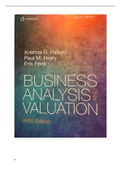1
,Inhoudsopgave
Chapter 1: A framework for business analysis and valuation using financial statements.................................3
Chapter 2: Strategy analysis........................................................................................................................... 6
Chapter 3: Accounting analysis: the basics.................................................................................................... 10
Chapter 4: Accounting analysis: accounting adjustments..............................................................................14
Chapter 5: Financial analysis........................................................................................................................ 22
Chapter 6: Prospective analysis: forecasting................................................................................................. 30
Chapter 7: Prospective analysis: valuation theory and concept.....................................................................36
Chapter 8: Prospective analysis: valuation implementation..........................................................................43
2
,Chapter 1: A framework for business analysis and valuation using financial statements
Capital markets play an important role in channeling financial resources from savers to business
enterprises that need capital. Financial statement analysis is a valuable activity when managers have
complete information on a firms strategies, and a variety of institutional factors make it unlikely that
they fully disclose this information to suppliers of capital.
The role of financial reporting in capital markets:
Funding business ideas with the highest prospects first is complicated for these reasons:
- Information asymmetry between savers and entrepreneurs
- Potentially conflicting interests – credibility problems
- Expertise asymmetry
Information and incentive issues lead to the lemons problem, which can break down the functioning
of the capital market. Half the ideas are good, half the ideas are bad. Over time bad ideas crowd out
good ideas and investors lose confidence in the market.
Financial intermediaries -> venture capital firms, pension funds etc..
Information intermediaries -> auditors, financial analysts etc..
Both add value by helping investors distinguish the good investment opportunities and the bad ones
The firm’s business strategy determines how the firm positions itself in its environment to achieve a
competitive advantage.
Firms typically produce five financial reports
- Income statement
- Balance sheet
- Cash flow statement
- Statement of other comprehensive income
- Statement of changes in equity
Influences of the accounting system on information quality:
- Accrual accounting
- Accounting conventions and standards
- Managers reporting strategy
- Auditing, legal liability and public enforcement
Accrual accounting:
Unlike cash accounting, accrual accounting distinguishes between the recording of costs or benefits
associated with economic activities and the actual payment or receipt of cash. Profit or loss is the
primary periodic performance index under accrual accounting. To compute profit or loss, the effects
of economic transactions are recorded on the basis of expected, not necessarily actual, cash receipts
and payments. Expected cash receipts from the delivery of products or services are recognized as
revenues, and expected cash outflows associated with these revenues are recognized as expenses.
Timing differences between the moment of recording costs or benefits and the moment of
experiencing cash inflows or outflows result in the recognition of assets and liabilities on the balance
sheet.
The need for accrual accounting arises from investors’ demand for financial reports on a periodic
basis. Because firms undertake economic transactions on a continual basis, the arbitrary closing of
3
, accounting books at the end of a reporting period leads to a fundamental measurement problem.
Because cash accounting does not report the full economic consequence of the transactions
undertaken in a given period, accrual accounting is designed to provide more complete information
on a firm’s periodic performance.
Because the mechanisms that limit managers’ ability to distort accounting data add noise, it is not
optimal to use accounting regulation to eliminate managerial flexibility completely. Therefore real-
world accounting systems leave considerable room for managers to influence financial statement
data. A firm’s reporting strategy – that is, the manner in which managers use their accounting
discretion – has an important influence on the firm’s financial statements.
Third-party auditing may also reduce the quality of financial reporting because it constrains the kind
of accounting rules and conventions that evolve over time. The potential for significant legal liability
might also discourage managers and auditors from supporting accounting proposals requiring risky
forecasts – for example, forward-looking disclosures. This type of concern has motivated several
European countries to adopt a less strict liability regime. Strict public enforcement can also reduce
the quality of financial reporting because, in their attempt to avoid an accounting credibility crisis on
public capital markets, enforcement bodies may pressure companies to exercise excessive prudence
in their accounting choices.
Alternative ways managers can communicate with external investors and analysts
- Analyst meetings, meet regularly with financial analysts that follow the firm
- Voluntary disclosure, voluntarily provide more information than necessary in financial
statements
o Disadvantage: competitive dynamics in product markets
o Managements legal liability
o Management credibility can limit a firms incentive to provide voluntary disclosures
- Non-financial reporting
o Such as ESG reporting
Because managers’ insider knowledge is a source of both value and distortion in accounting data, it is
difficult for outside users of financial statements to separate accurate information from distortion
and noise. Not being able to undo accounting distortions completely, investors “discount” a firm’s
reported accounting performance. In doing so, they make a probabilistic assessment of the extent to
which a firm’s reported numbers reflect economic reality. As a result, investors can have only an
imprecise assessment of an individual firm’s performance. Financial and information intermediaries
can add value by improving investors’ understanding of a firm’s current performance and its future
prospects.
From financial statements to business analysis:
1. Business strategy analysis, identify key profit drivers and
business risks and to assess the company’s profit potential
at a qualitative level. Business strategy analysis involves
analyzing a firm’s industry and its strategy to create a
sustainable competitive advantage
2. Accounting analysis, evaluate the degree to which a firm’s
accounting captures the underlying business reality. By
identifying places where there is accounting flexibility, and
by evaluating the appropriateness of the firm’s accounting
policies and estimates, analysts can assess the degree of
distortion in a firm’s accounting numbers
4






